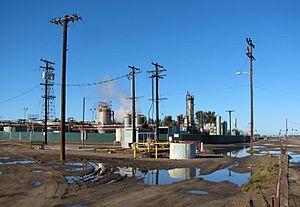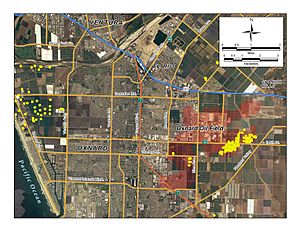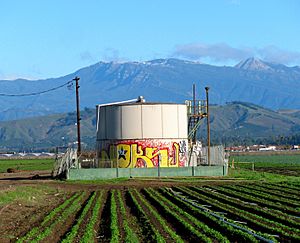Oxnard Oil Field facts for kids
The Oxnard Oil Field is a large area in Oxnard, Ventura County, California, where oil is found deep underground. While most of the easily accessible oil has already been taken out, this field still holds a huge amount of a very thick, heavy type of oil called tar sands. It's like super-thick syrup that's hard to get out of the ground! Companies like Tri-Valley Oil & Gas Co. and Occidental Petroleum (through its Vintage Production company) are working here. As of early 2009, there were 34 active wells pumping oil from this field.
Contents
Where is the Oxnard Oil Field?
The Oxnard Oil Field is located under the Oxnard Plain, which is mostly farmland. You'll see oil wells and equipment mixed in with fields growing strawberries, broccoli, and onions. It's a unique sight to see farming and oil production happening side-by-side!
The field is near major roads like U.S. Highway 101 and California State Route 34. Most of the active oil wells are in the eastern part of the field. The entire area where oil is found covers about 1,350 acres.
Weather and Land Around the Field
The weather here is like a Mediterranean climate. This means cool, rainy winters and warm, sunny summers. The ocean helps keep the summer heat from getting too extreme, often bringing morning fog. It rains about 15 inches a year, mostly in winter. Temperatures usually stay between 56 and 60 degrees Fahrenheit.
The land is mostly flat, only about 40 to 60 feet above sea level. Water drains into nearby creeks and then flows out to the Pacific Ocean.
What is the Geology of the Oxnard Oil Field?
The Oxnard field is part of a larger area in Southern California called the Ventura Basin. This area has many layers of sedimentary rock, which are rocks formed from sand, mud, and tiny bits of ancient plants and animals. Oil often forms in these rocks and gets trapped in certain shapes, like underground domes or folds, or by faults (cracks in the Earth's crust).
Underneath the flat surface, there are many layers of rock. Some layers are like sponges, holding oil, while others are like caps, trapping the oil below. One important layer is called the "McInnes" pool, which holds medium-grade oil about 6,500 feet deep.
Understanding Tar Sands
The Oxnard field is famous for its large amount of tar sand. This is a type of bitumen, which is a very thick, sticky form of oil. Think of it like asphalt or tar you see on roads, but underground! These tar sands are found about 2,500 feet below the surface and can be up to 600 feet thick.
It's very hard to get this super-heavy oil out. Companies use special methods like steam injection. This involves pumping hot steam into the ground to warm up the tar sands, making the oil thinner and easier to pump out. Some test wells have shown good results, producing a lot of oil once the steam equipment is in place.
The oil from the deeper parts of the field is of good quality, but the oil from the tar sands is very heavy and has a lot of sulfur. It's much harder to process.
History and Operations of the Oil Field
The Oxnard Oil Field was first discovered in January 1937 by a company called Vaca Oil Exploration Co. They found tar sands about 2,800 feet deep and were able to get about 50 barrels of oil per day. Later that year, they found more tar sands in another rock layer and produced even more oil.
Over time, drillers found even deeper layers with lighter, easier-to-pump oil. In the 1950s, new oil pools like McInnes, Lucas, and Livingston were discovered. To help get more oil out, companies used a method called waterflooding, where water is injected into the ground to push the oil towards the wells.
Many of these deeper wells were eventually closed as the oil ran out. However, some were kept to inject wastewater back into the ground. This is a safer and more environmentally friendly way to get rid of the water that comes up with the oil. As of 2008, most active wells were in the shallow tar sands, with only a couple still working in the deep McInnes layer.
Redeveloping Old Wells
Sometimes, oil companies go out of business, and their wells are left unused. In California, there's a rule that allows other companies to "adopt" these abandoned wells. Tri-Valley Oil & Gas Company took over 20 wells that were left by a company that went bankrupt. They started working on these wells again to bring them back into production.
The oil collected from the Oxnard field is sent to a small refinery nearby, owned by Tenby, Inc. This refinery also processes oil from the West Montalvo Oil Field, which is located to the west.
Managing Oil Field Waste
Oil production creates waste, mostly salty water called brine. It's important to dispose of this waste safely. Anterra Energy Services, Inc. operates a facility in Ventura County that injects this oil field waste deep underground. This is the only commercial facility of its kind in the county.
The permit for this facility is set to expire in 2018. The county has changed its rules, and new commercial oil disposal sites are no longer allowed on farmland. The county leaders believe there are other suitable industrial areas for such facilities. They want to make sure that waste disposal is done in the safest and most appropriate locations. Anterra can still apply to continue its current operations when the permit expires.
Images for kids






